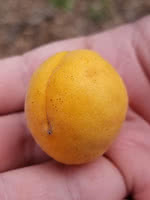Mon-Fri 9am - 5pm Mountain time
Manchurian Apricot vs Garrington Chokecherry
Prunus armeniaca var. mandshurica
Prunus virginiana Garrington
NOT AVAILABLE THIS SEASON - MIGHT RETURN
Manchurian Apricot is a winter-hardy relative of the native plum. This tree can stand some drought, but will not handle standing water or saturated moist soils. It can be used in shelterbelts, hedges, or as an ornamental. Manchurian Apricot will also attract songbirds, rabbits, and other rodents if left uncontrolled.
This tree will produce fruit once it reaches maturity at between two and five years old. Other famous cultivars of Manchurian Apricot include Scout Apricot, Moongold, and many more.
Garrington Chokecherry is a self-fertile and rare chokecherry that is commonly used for commercial orchards. This highly prized selection is known for its heavy yields of large, reddish-black fruit that are easily harvested with an over row harvester.
Garrington Chokecherry is also commonly used for hedges and edible landscaping. This shrubs' chokecherries are commonly used in baking, preserves, wine, and jams or jellies.

